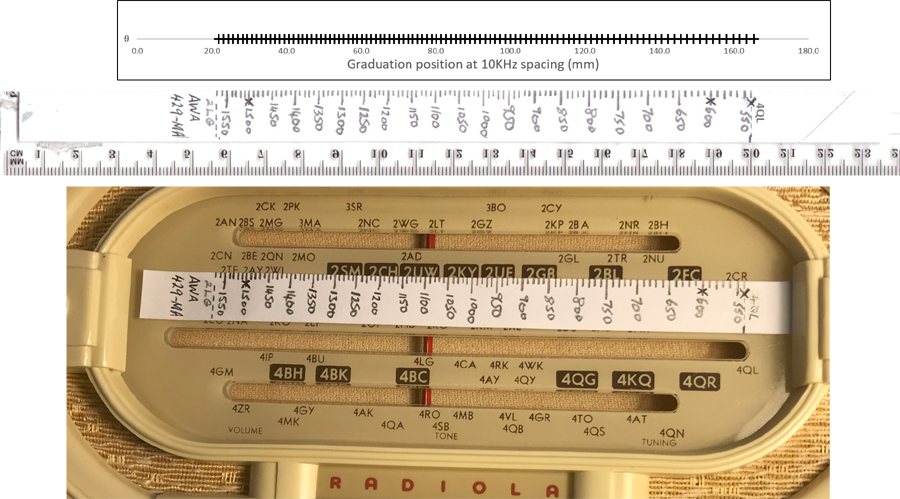Tech Talk
Forum home - Go back to Tech talk
|
Frequency dial scale for AWA Radiola 429-MA
|
|
|
« Back ·
1 ·
Next »
|
|
|
Return to top of page · Post #: 1 · Written at 3:05:53 PM on 11 June 2025.
|
|
|
|
Location: NSW
Member since 10 June 2010 Member #: 681 Postcount: 1379 |
|
I haven't been able to do any hands on work for a while so thought I would contribute a frequency dial scale for the AWA Radiola 429-MA which was made some time ago.  |
|
|
Return to top of page · Post #: 2 · Written at 5:06:35 PM on 11 June 2025.
|
|
|
|
Administrator
Location: Naremburn, NSW
Member since 15 November 2005 Member #: 1 Postcount: 7564 |
|
Photo uploaded. ‾‾‾‾‾‾‾‾‾‾‾‾‾‾‾‾‾‾‾‾‾‾‾‾‾‾‾‾‾‾‾‾‾‾‾‾‾‾‾‾‾‾‾‾‾‾‾‾‾‾‾‾‾‾‾‾‾‾‾‾‾‾‾‾‾‾‾‾ A valve a day keeps the transistor away... |
|
|
Return to top of page · Post #: 3 · Written at 9:55:08 AM on 13 June 2025.
|
|
|
|
Location: Wangaratta, VIC
Member since 21 February 2009 Member #: 438 Postcount: 5606 |
|
For rough dial calibration 2AY went from 1500 to 1495 and 3SR 1260 being devisable by 9 stayed put, up the top & middle. |
|
|
Return to top of page · Post #: 4 · Written at 5:27:18 PM on 13 June 2025.
|
|
|
|
Location: NSW
Member since 10 June 2010 Member #: 681 Postcount: 1379 |
|
If 2AY was 1500, it doesn'r agree with my scale where it is 1480-1490. What to make of that? I suppose as long as it was close that was good enough, or the draftsman made an error. |
|
|
Return to top of page · Post #: 5 · Written at 10:58:37 PM on 13 June 2025.
|
|
|
|
Location: Wangaratta, VIC
Member since 21 February 2009 Member #: 438 Postcount: 5606 |
|
The problem was for some bizarre excuse, possibly related to revenue. somewhere about the late 70's they changed from a separation of tens to apparently a European separation of nine, then to make it even more crazy, like rendering all TV's obsolete. They reallocated the frequencies. |
|
|
Return to top of page · Post #: 6 · Written at 9:00:06 AM on 14 June 2025.
|
|
|
|
Location: NSW
Member since 10 June 2010 Member #: 681 Postcount: 1379 |
|
I used List of Australian AM radio stations in Wikipedia because it has old and new frequencies side by side. Wavelengths are there also for those interested. |
|
|
Return to top of page · Post #: 7 · Written at 9:42:25 AM on 14 June 2025.
|
|
|
|
Location: Hill Top, NSW
Member since 18 September 2015 Member #: 1801 Postcount: 2216 |
|
2AY is on 1494, not 1495. |
|
|
Return to top of page · Post #: 8 · Written at 9:47:17 AM on 14 June 2025.
|
|
|
|
Location: Wangaratta, VIC
Member since 21 February 2009 Member #: 438 Postcount: 5606 |
|
That rather runs with my comment more room more revenue. |
|
|
Return to top of page · Post #: 9 · Written at 8:10:48 PM on 14 June 2025.
|
|
|
|
Location: NSW
Member since 10 June 2010 Member #: 681 Postcount: 1379 |
|
Should have noticed that the numbers in 1495 don't add up to 9, 18 or 27. |
|
|
Return to top of page · Post #: 10 · Written at 9:21:19 PM on 14 June 2025.
|
|
|
|
Location: Wangaratta, VIC
Member since 21 February 2009 Member #: 438 Postcount: 5606 |
|
AM may have worse sound quality and be more subject to interference, like it can pick up lightning from a substantial distance. Anderson actually discovered both AM and FM where the frequency wobbles with the audio. |
|
|
« Back ·
1 ·
Next »
|
|
|
You need to be a member to post comments on this forum.
|
|

Sign In

Vintage Radio and Television is proudly brought to you by an era where things were built with pride and made to last.
DISCLAIMER: Valve radios and televisions contain voltages that can deliver lethal shocks. You should not attempt to work on a valve radio or other electrical appliances unless you know exactly what you are doing and have gained some experience with electronics and working around high voltages. The owner, administrators and staff of Vintage Radio & Television will accept no liability for any damage, injury or loss of life that comes as a result of your use or mis-use of information on this website. Please read our Safety Warning before using this website.
WARNING: Under no circumstances should you ever apply power to a vintage radio, television or other electrical appliance you have acquired without first having it checked and serviced by an experienced person. Also, at no time should any appliance be connected to an electricity supply if the power cord is damaged. If in doubt, do not apply power.
Shintara - Keepin' It Real · VileSilencer - Maintain The Rage
